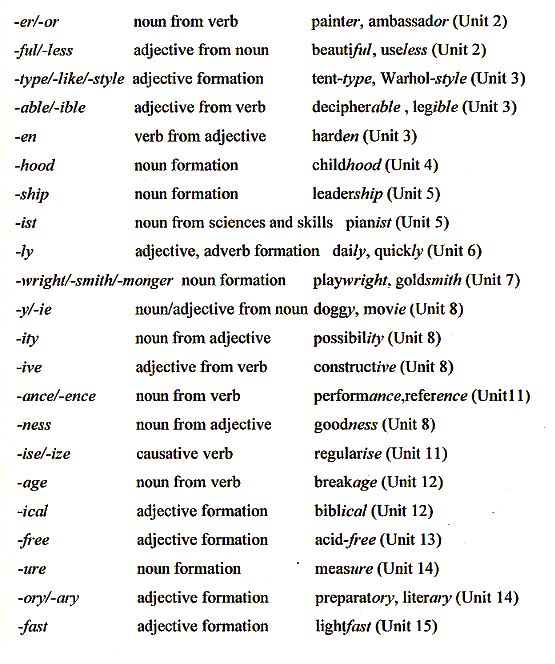
-ment e –tion are added to verbs to form abstract nouns:
• to develop > development
• to represent > representation
There can be variation with the latter
- sion > decision, persuasion
- ion > regression, discussion
the suffixes –er, -or are used for jobs and social roles: painter, ambassador.
To indicate sex:
- ess > actor > actress
- ette > usher > usherette
- man/woman > policeman, policewoman
Now – person has replaced –man/woman
- person > barman/barwoman >> barperson
-ful added to nouns means ‘full of’
• skill > skilful
-less has the opposite meaning
• doubt > doubtless
-type is used to dente something which looks or behave like
something else
• tent-type cameras
But there are also:
-like > lifelike
-style > Worhol –style photgrphy
They are usually added to nouns and are used when suffix –y or –ly is not possible.
Suffixes –able or –ible are used
to denote the idea of ‘being able to’, or ‘subject
to’ and are added to verbs to form an adjective:
• Decipher > decipherable
The Suffix –en is added to adjectives or nouns to form verb: The verb means ‘to make something be’ like that particular adjective or noun:
• Black > blacken (the silver nitrate blackened in the
sun)
• Hard > harden (the material hardened in the exposure)
The suffix –hood is added to nouns to form an abstract
noun which means ‘the state of being’
:
• Child > childhood
Prefixes to denote negation:
Un- > uncertainty, unlike
In-: independent, infinite
Non-: non-linear, non-sequential
Ir-: responsible – irrisponsible
Il-: illegal
Im: impossible
Non- is used with a noun or an adjective and is generally connected with a hyphen, though this is not always so:
Non-interventionist, nonsense
Mis- is used with adjectives, nouns, and verbs and gives the meaning of ‘badly’, ‘wrongly’:
Place> misplace
Understand> misunderstand
Here is the tendency to leave out the hyphen.
- ship is added to noun to form an abstract noun and gives
the meaning of ‘the state of being’:
leader > leadership
It is also used to tlak about a skill:
Workman >> workmanship (draftmanship)


From: Appendix 2, Prefixes and Suffixes, in Frederika Gebhardt, English for the Arts, CaFoscarina Venezia 2000, pag 288.